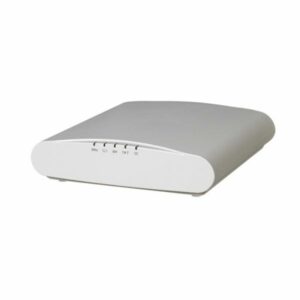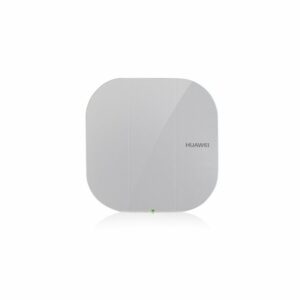Subtotal: AED1,498.00
AP4050DE-M Overview
Huawei AP4050DE-M is an 802.11ac Wave 2 access point (AP) that supports 2×2 MIMO and two spatial streams. It provides comprehensive service support capabilities and features high reliability, high security, simple network deployment, automatic AC discovery and configuration, and real-time management and maintenance, which meets network deployment requirements. The AP has built-in smart antennas and supports smooth evolution from 802.11n to 802.11ac and can provide gigabit access for wireless users.
Quick Spec
Table 1 shows the Quick Specs.
| Product Code | AP4050DE-M |
| Dimensions (H x W x D) | 45 mm x 200 mm x 200 mm |
| Interface type | 1 x 10/100/1000M self-adaptive Ethernet interface (RJ45)
1 x Management console port (RJ45) |
| Built-in Bluetooth | BLE5.0 |
| LED indicator | Indicates the power-on, startup, running, alarm, and fault states of the system. |
| Power input l | • DC: 12 V ± 10%
• PoE power supply: in compliance with IEEE 802.3at |
| Maximum power consumption
|
16.3 W
NOTE The actual maximum power consumption depends on local laws and regulations. |
| Maximum number of SSIDs for each radio | ≤ 16 |
| Maximum number of users
|
≤ 512
NOTE The actual number of users varies according to the environment. |
Product Details
Huawei AP4050DE-M provides these features:
• 802.11ac Wave 2 standards compliance, MU-MIMO (2SU-2MU), delivering services simultaneously on 2.4G and 5G radios, at a rate of up to 400 Mbit/s at 2.4 GHz, 867 Mbit/s Mbit/s at 5 GHz, and 1.267 Gbit/s for the device.
• Smart antenna array technology enables targeted signal coverage for mobile terminals, reduces interferences, and improves signal quality. Additionally, it implements millisecond-level switchover as STAs move.
• Built-in Bluetooth 5.0, increasing the working distance and working with eSight to accurately locate Bluetooth terminals.
• Supports the Fat, Fit, and cloud modes and enables Huawei cloud-based management platform to manage and operate APs and services on the APs, reducing network O&M costs
Compare to Similar Items
Table 2 shows the comparison.
| Product Code | AP4050DE-M | AP4151DN |
| Dimensions (H x W x D) | 45 mm x 200 mm x 200 mm | 35mm x 170mm x 170mm |
| Interface type | 1 x 10/100/1000M self-adaptive Ethernet interface (RJ45)
1 x Management console port (RJ45) |
2 x 10/100/1000M self-adaptive Ethernet interface (RJ45)
Console interface(RJ45 x 1) 1 x USB interface |
| Built-in Bluetooth | BLE5.0 | \ |
| Power input |
• DC: 12 V ± 10%
• PoE power supply: in compliance with IEEE 802.3at |
DC: 12 V ± 10%
PoE power supply: in compliance with IEEE 802.3af/at (not support USB when in 802.3af) |
| Maximum power consumption | 16.3 W | 12.3W (excluding the output power of the USB port) |
| Antenna type | Built-in dual-band smart antenna | External antennas(horizontal beamwidth 360°) |
| Antenna gain | 2.4GHz: 4.5dBi
5GHz: 6dBi |
3.5 dBi (2.4 GHz); 4 dBi (5 GHz) |
AP4050DE-M Specification
AP4050DE-M Specification |
|
| Dimensions (H x W x D) | 45 mm x 200 mm x 200 mm |
| Weight | 0.7 kg |
| Interface type | 1 x 10/100/1000M self-adaptive Ethernet interface (RJ45)
1 x Management console port (RJ45) |
| Built-in Bluetooth | BLE5.0 |
| LED indicator | Indicates the power-on, startup, running, alarm, and fault states of the system. |
| Power input l | • DC: 12 V ± 10%
• PoE power supply: in compliance with IEEE 802.3at |
| Maximum power consumption
|
16.3 W
NOTE The actual maximum power consumption depends on local laws and regulations. |
| Operating temperature | –10°C to +50°C |
| Storage temperature | –40°C to +70°C |
| Operating humidity | 5% to 95% (non-condensing) |
| Dustproof and waterproof grade | IP41 |
| Altitude | –60 m to +5000 m |
| Atmospheric pressure | 53 kPa to 106 kPa |
| Antenna type | Built-in dual-band smart antenna |
| Antenna gain | 2.4GHz: 4.5dBi
5GHz: 6dBi NOTE • The gains above are the single-antenna peak gains. • The equivalent antenna gain after all 2.4 GHz or 5 GHz antennas are combined is 3dBi in 2.4 GHz or 3dBi in 5 GHz. |
| Maximum number of SSIDs for each radio | ≤ 16 |
| Maximum number of users
|
≤ 512
NOTE The actual number of users varies according to the environment. |
| Maximum transmit power
|
2.4G: 27 dBm (combined power)
5G: 27 dBm (combined power) NOTE The actual transmit power depends on local laws and regulations. |
| Power increment | 1 dBm |
| Maximum number of non-overlapping channels
|
2.4 GHz (2.412 GHz to 2.472 GHz)
• 802.11b/g − 20 MHz: 3 • 802.11n − 20 MHz: 3 − 40 MHz: 1 5 GHz (5.18 GHz to 5.825 GHz) • 802.11a − 20 MHz: 13 • 802.11n − 20 MHz: 13 − 40 MHz: 6 • 802.11ac − 20 MHz: 13 − 40 MHz: 6 − 80 MHz: 3 NOTE The table uses the number of non-overlapping channels supported by China as an example. The number of non-overlapping channels varies in different countries. For details, see the Country Codes & Channels Compliance. |
| Channel rate supported
l |
• 802.11b:1、2、5.5 和 11Mbit/s
• 802.11a/g:6、9、12、18、24、36、48 and 54Mbit/s • 802.11n:6.5~400Mbit/s • 802.11ac wave2:6.5~867Mbit/s |
| Receiver sensitivity (Typical values) | • 2.4 GHz 802.11b : -103 dBm @ 1 Mbit/s -95 dBm @ 11 Mbit/s
• 2.4 GHz 802.11g : -96 dBm @ 6 Mbit/s -80 dBm @ 54 Mbit/s • 2.4 GHz 802.11n (HT20): 96 dBm @ MCS0 -75 dBm @ MCS15 • 2.4 GHz 802.11n(HT40): -94 dBm @ MCS0 -73 dBm @ MCS15 • 5 GHz 802.11a : -94 dBm @ 6 Mbit/s -79 dBm @ 54 Mbit/s • 5 GHz 802.11n (HT20): -90 dBm @ MCS0 -74 dBm @ MCS15 • 5 GHz 802.11n (HT40): -91 dBm @ MCS0 -72 dBm @ MCS15 • 5 GHz 802.11ac (VHT20): -94 dBm @ MCS0NSS1 -70 dBm @ MCS8NSS2 • 5 GHz 802.11ac (VHT40): -92 dBm @ MCS0NSS1 -67 dBm @ MCS9NSS2 • 5 GHz 802.11ac (VHT80): -89 dBm @ MCS0NSS1 -64 dBm @ MCS9NSS2 |
| Safety standards | • UL 60950-1
• CAN/CSA 22.2 No.60950-1 l • IEC 60950-1 l • EN 60950-1 l • GB 4943 |
| Radio standards | • ETSI EN 300 328
• ETSI EN 301 893 • China’s SRRC document [2002] No. 353 • China’s SRRC document [2002] No. 277 • China’s SRRC document [2012] No. 620 • FCC Part 15C: 15.247 • FCC Part 15C: 15.407 • RSS-210 • AS/NZS 4268 |
| EMC standards l | • EN 301 489-1 l
• EN 301 489-17 • ETSI EN 60601-1-2 l • FCC Part 15 • ICES-003 • YD/T 1312.2-2004 • ITU k.20 • GB 9254 • GB 17625.1 • AS/NZS CISPR22 • EN 55022 • EN 55024 • CISPR 22 • CISPR 24 • IEC61000-4-6 l • IEC61000-4-2 |
| IEEE standards
|
• IEEE 802.11a/b/g
• IEEE 802.11n • IEEE 802.11ac • IEEE 802.11h • IEEE 802.11d • IEEE 802.11e • IEEE 802.11k • IEEE 802.11u • IEEE 802.11v • IEEE 802.11w • IEEE 802.11r |
| Security standards | • 802.11i, Wi-Fi Protected Access 2(WPA2), WPA
• 802.1X • Advanced Encryption Standards(AES),Temporal Key Integrity Protocol(TKIP) • EAP Type(s) |
| EMF l | • CENELEC EN 62311
• CENELEC EN 50385 • OET65 • RSS-102 • FCC Part1&2 • FCC KDB series |
| RoHS l | Directive 2002/95/EC & 2011/65/EU |
| Reach l | Regulation 1907/2006/EC |
| WEEE | Directive 2002/96/EC & 2012/19/EU |
 QNAP TR-004-US 4-Bay USB 3.0 Type-C 5Gbps Hardware RAID DAS Enclosure
QNAP TR-004-US 4-Bay USB 3.0 Type-C 5Gbps Hardware RAID DAS Enclosure  Kingwin TD-2535U3 USB To SATA Docking Station
Kingwin TD-2535U3 USB To SATA Docking Station  04 3550600
04 3550600 052 7036860
052 7036860






There are no reviews yet.